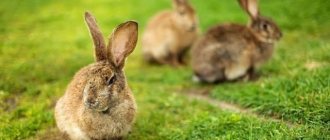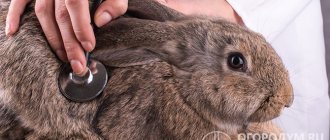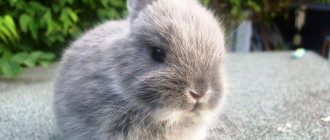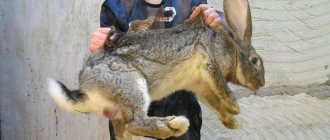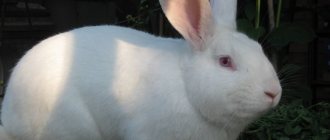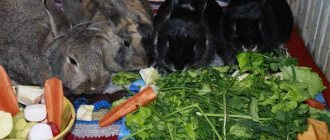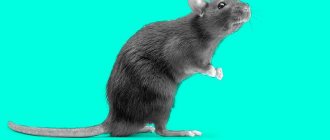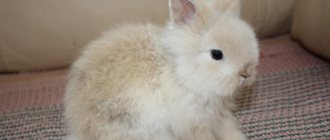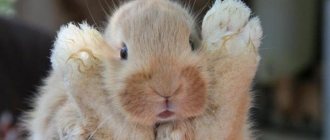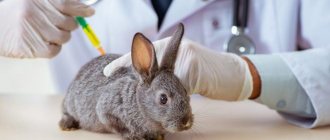Rabbits have their own body language. How can you understand what a rabbit grunting, stomping, or falling on its side wants to say with its behavior? The body language of domestic rabbits is no different from the body language of their wild relatives. By observing wild rabbits, you can understand what exactly the domestic rabbit wants to express. Zoologists and scientists who study animal behavior have been studying the behavior of rabbits for a long time and continue to study them.
In addition to the usual behavior inherent in this particular type of animal, rabbits suffer from behavioral disorders as a result of improper maintenance and diseases. Read more about anomalous behavior here.
Behavioral reactions of rabbits
Eared animals express their sensations, emotions, and states through certain behavior. Moreover, the same movements of individuals can have different reasons.
For example, an animal tapping its paws on the floor in different situations can mean fear, excitement, irritation, dissatisfaction.
In some cases, the rabbit thus strives to attract the owner’s attention and warn its relatives about imminent danger.
Some behavioral manifestations indicate unfavorable housing and feeding conditions. It is still impossible to unambiguously interpret the different behavior of these animals, since it often changes in accordance with the different conditions of their habitat.
Various bodily signals and behavior of eared animals are a means of their self-expression. Only by understanding animals can we find the most appropriate approach to them.
This is interesting: Keeping rabbits outside in winter - we present them in order
Measures to prevent night noises in domestic rabbits
If a decorative rabbit makes noise at night, making separate knocks or chatter, then in this way it attracts the attention of its owners to its problems, expresses dissatisfaction when it feels loneliness, hunger, or lack of attention. To prevent such negative manifestations, you need to spend more time with your pet during the day. It is advisable to maintain cleanliness in the cage and the usual arrangement of all objects inside it.
Make sure your rabbit always has access to clean drinking water and food.
It is advisable to maintain cleanliness in the cage and the usual arrangement of all objects inside it. Make sure your rabbit always has access to clean drinking water and food.
To prevent such negative manifestations, you need to spend more time with your pet during the day. It is advisable to maintain cleanliness in the cage and the usual arrangement of all objects inside it. You need to make sure that your rabbit always has access to clean drinking water and food.
If the animal is allowed out for walks at night, then the cage door must be left open so that at any time it can return to its usual conditions and hide in a safe place.
Knocking at night may be an indication that the animal needs a mate. If this is not possible, then soft, rubber toys and a ball will help brighten up the rabbit’s loneliness.
A caring attitude, understanding their needs and body language will help you get closer to your beloved pets. Sometimes you need to call a veterinarian, but most often you can solve the maintenance problem on your own.
If your pet shows aggression, then the article “How to stop a rabbit from biting” will help you understand the situation.
If the information presented above is of interest to you and answers some pressing questions, then please like it.
Rabbits have their own “language” of communication, like all mammals that live in groups. In humans, a similar, nonverbal form of communication (without words) is called body language.
Does a pet need friends?
Anyone who has kept rabbits for a long time will tell you that these animals are sociable, playful and inquisitive. Having recognized their owner, they happily bat their eyelashes and wiggle their tails. In their natural habitat, rabbits gather in groups, with the exception of the earthen rodent, which is the only one that prefers solitude. The rest, both the rabbit and the hare, left alone, can become very bored and even depressed.
If you are not planning on breeding, then it is better to keep in a cage either one pet or a pair of individuals that have the same gender. Sterilization and castration will help solve the problem with living space.
These animals tend to fight for territory, so introduce newcomers into the cage carefully and at first monitor the behavior of the pets as often as possible. This will help you minimize stress.
Small rabbits need to be picked up carefully and slowly, try not to scare them. It is not advisable to pick up fluffies by just the ears or just the scruff of the neck. The correct way to do this is to press the ears to the body with one hand, grab the animal by the scruff of the neck through them, and slightly lift it, supporting the body from below with the other hand.
Practical use of any rabbit signals
A person who professionally raises rabbits uses rabbit signals and understands their meaning:
- sexual arousal (the female rabbit's immobile posture is the beginning of estrus, lifting her tail, raising her butt is a sign of readiness for mating);
- aggression (transmitted by sounds, throws, posture of readiness to throw)
- fear (posture of submission, sounds of submission).
The above is the most important information used when carrying out matings of male and female rabbits, uniting groups of rabbits for joint keeping (pit rabbit keeping), keeping a female rabbit with rabbits.
How does the treatment work?
Paralysis of the hind limbs always entails side effects, so treatment includes various measures. The animal is given painkillers and anti-inflammatory drugs to relieve discomfort and prevent inflammation of the nerves and tissues at the site of the lesion. All medications are prescribed by a doctor, and the task of the animal owner is to remember all the recommendations and follow them exactly.
For rehabilitation, the rabbit needs to have a massage
It is necessary to massage the hind legs to quickly restore their mobility. This method avoids tissue death and improves blood flow. Artificial gymnastics will help the animal fully restore motor functions and coordination.
It is very simple to carry out: you need to slowly and carefully bend and unbend your paws for several minutes. If an individual with paralyzed hind legs generally feels well, then it can and should be taken for a walk in the fresh air and allowed to crawl on the grass under supervision
Diet of rabbits in the wild
Rabbits are unpretentious in their choice of food and eat all the plants available to them. After all, animals stay close to their burrows while feeding, so their menu is not very diverse. In summer, the diet of furry creatures consists of green grass, cereals, seeds, tubers, leaves and plant roots. Animals living near fields do not miss the opportunity to eat carrots, cabbage and lettuce. In winter, rabbits feed on dry grasses, bush branches and tree bark, and also dig edible root vegetables from the ground.
Rabbits are prone to coprophagy, that is, eating their own excrement, but only if natural food is in short supply and they have to starve for a long time.
How a rabbit expresses aggression and more
What he wants to say, what you should pay attention to, what the rabbit owner should notice
And it doesn’t matter whether a decorative or productive rabbit knocks its paws. All the same, if a rabbit knocks its hind legs, in the rabbit’s body language, it means that the pet is experiencing one or more feelings at the same time
All the same, if a rabbit knocks its hind legs, in the rabbit's body language, it means that the pet is experiencing one or more feelings at the same time.
Experts believe that rabbits’ aggression towards their relatives is a completely normal phenomenon. Juveniles often hit each other. With painless bites, herbivores can indicate to their family members that they must respect the hierarchy.
How can you tell if your pet is preparing to attack a person? Before the attack, he takes a characteristic pose - he presses his ears to his back and stretches his body forward. Herbivores that are kept alone in a cage often show aggression.
The less attention they show to the animal, the more aggressive it becomes. The long-eared cat can bite the owner on the forearm in case of resentment and anger
Rabbits are peaceful and gentle animals. With proper care, they will never offend either a person or another pet. However, in some cases, rabbits show aggression:
- They hiss and make sounds similar to a growl or scream, so they try to drive away possible enemies. If a pet behaves this way around small children, then it is better to prohibit them from approaching the animal, since trying to defend itself, it may bite the child.
- When a female rabbit begins to restlessly jump and fidget all day and night, this is often not a sign of anger, but a signal that she is ready for mating. Males express their readiness to mate in this way; in addition, they can make guttural sounds.
- The animal grinds its teeth, rolls on the floor, refuses to eat, its temperature is elevated - these are the first signs of illness. Consult your veterinarian.
- If a pet presses itself to the floor, when a person approaches, it begins to back away and hides in a corner, it experiences severe fear. If the source of concern is not removed, he will defend himself: he will start waving his paws, hissing, and biting. Keep an eye on your pet while he walks around the house so that he does not cause harm to anyone.
- One of the reasons that a rabbit hits the cage floor with its hind legs may be aggression towards its relatives, people or other pets.
- If an animal scratches wooden and plastic objects in a cage, sharpens its claws on upholstered furniture and toys, it is worried before mating, simply plays or tries to take out its anger on objects.
The “language” of the rabbit - let's master it together
Knowledge of unique poses and movements will help you better understand the animal; this is the language of rabbits. We offer a small list from the list, such as: – If a rabbit.
- Standing on its hind legs - the desire to see better. what's happening.
- Rubbing his chin - most likely leaving his marks.
- Grunts - when he plays, when he is cornered and cannot escape, beware, I will attack.
- Squeaks - driven into a corner, very afraid.
- Often jumps several times in a row, vanity, this is either a dance of love or, on the contrary, fear.
- Lies on its side or presses itself to the ground when a person approaches, I'm afraid, don't touch.
- Shows an unhealthy interest in things - it’s time for castration.
- Teeth grinding is a reaction to pain.
- Restless is a sign of pain, fear, which in one word is called stress, observe, if the reason is unclear, contact your veterinarian for advice by phone;
- Huddles in a corner for a long time - fright, if it continues all day - contact a veterinarian with the animal;
- Scratching himself in one place - there is pain, itching, irritation in this place - contact your veterinarian by phone;
- Refuses food all day - contact your veterinarian by phone;
- Hot ears (nose) - either heat outside (threat of heat stroke) or illness (look for additional three signs of illness, such as refusal to feed, depression, diarrhea). Otherwise, hot ears mean that the rabbit is warm, also with a hot nose on a decorative rabbit.
Prevention measures
Preventative measures can reduce the risk of paralysis by 50%. To protect your pet from such a fate, adhere to the following rules:
- Have your rabbit checked regularly by a veterinarian.
- Monitor the animal's diet. He should get plenty of fiber, as well as other vitamins and minerals in sufficient quantities.
- Keep your pet clean. Clean your rabbit's cage, tray, and feeder regularly.
- Do not leave your animal unattended for a long time, especially during walks, to avoid injury.
- You should provide him with the most peaceful life possible. Do not provoke fear and stress in him.
- If there are children in the family, make sure that their games with the rabbit are not harmful to the animal.
Feeding
Adult rabbits should eat more hay. The diet should also include food and a variety of greens. The water in the drinking bowl should not be oversaturated with calcium.
Rabbit diet:
| Daily | Hay (constantly), food and vegetables (limited), water. |
| Periodically | Fruits, carrots |
| Rarely | Hercules (without sugar) – recommended for sick, weak animals. |
You cannot feed animals milk, meat, fatty foods, sweets, bread, nuts, grains, seeds, or chocolate.
When does a rabbit stop being silent and start screaming?
However, in rare cases, rabbits can still give their voice. In moments of extreme danger or severe pain, they emit a piercing scream or rather a squeal. They try to endure ordinary pain in silence. For wild rabbits, this innate quality often saves their lives, since enduring pain means preventing themselves from being detected by a predator. In households, on the contrary, it can play a cruel joke. Often a sick pet does not reveal itself in any way and thereby misleads inexperienced farmers. Only at the last moment does the rabbit suddenly begin to squeal loudly and immediately die in front of the owner’s eyes. But timely treatment could certainly correct the situation.
The loud screams of rabbits can also be heard during their martial arts. If, for example, a wild brother defends his right to a certain territory or two adult males were inadvertently placed in one cage, as well as during a planned replacement of a male during pit (aviary) keeping. At first, the animals seem to measure their strength, then the strongest begins to pursue the weaker. Sharp teeth turn out to be formidable weapons, the bites of which cause severe pain. Yes, and hitting with paws can lead to irreparable losses.
A brief excursion into the history of rabbits
The life path of furry animals goes back many millions of years, during which they survived many disasters and climate changes, managing to adapt to all the vagaries of nature.
Origin and evolutionary path
The order of lagomorphs, to which rabbits belong, appeared on earth about 65 million years ago during the Paleocene era. The formation of animals took place in Central Asia, from which they spread throughout the Northern Hemisphere. These animals were primitive mammals, and, judging by the fossil remains, they had an elongated body, long strong limbs and small round ears. Their diet consisted of grass, tree branches and leaves of bushes, and they did not move by jumping, like modern rabbits, but relied on all four paws when walking.
This is what the common ancestor of hares and rabbits looked like
A warm climate, an abundance of plant foods, and the absence of large predators contributed to the rapid evolution of small herbivorous mammals. Already in the Miocene, the hare family consisted of more than 200 species; they gradually acquired features inherent in modern hares and rabbits. About 35 million years ago, the ancient ancestors of the rabbit split from the lagomorphs, and their evolution took a different path. During the first ice age, which began 2.5 million years ago, rabbits, common throughout Europe, migrated south and settled in the Iberian Peninsula, where they safely survived all natural disasters and managed to survive to this day.
How and when were rabbits domesticated?
Compared to other domesticated animals, the domestication of rabbits is relatively recent and dates back to around the 2nd millennium BC. Judging by the surviving ancient scrolls, these animals were kept in Ancient Egypt and the Roman Empire, which was even mentioned by famous ancient historians.
But targeted breeding of rabbits began only in the early Middle Ages. and dates from around the 6th century. There is even a legend associated with furry animals, according to which Pope Gregory I officially declared rabbits... fish, thereby giving permission to eat rabbit meat during Lent. And the monks hastened to take advantage of this opportunity and began to breed these creatures at the monastic courts.
French monks managed to tame rabbits
Scientists, interested in this myth, examined ancient documents in detail and were able to prove that the story about dad and the rabbits is pure fiction. But what can be considered reliable is the fact that the French monks were actually the first to start raising rabbits, and even tried to breed new breeds.
From France, the experience of raising domestic rabbits migrated first to Belgium and Switzerland, and a little later farmers from Holland, Germany and England began breeding them. Over time, rabbit breeding spread not only throughout Europe, but also to other continents, and today their meat and fur remain in demand throughout the world.
Possible preventive measures
Pathology can be successfully avoided if due attention is paid to the conditions of keeping rabbits. Firstly, you need to take care of proper nutrition: animals should receive a full range of vitamins and microelements; lactating rabbits and young animals should be given calcium supplements
Secondly, cages and premises must be promptly cleaned, disinfected, and monitored to ensure that rodents do not enter them. Sick pets need to be isolated from others in a timely manner. Thirdly, you need to look after the rabbits while walking so that they do not fight, fall from great heights, bump into sharp objects, get injured or break their paws or spine.
One of the preventive measures is a nutritious diet.
Features of treating rabbits
A broken limb in a rabbit requires splinting and medication.
If the hind legs are damaged, the pet must receive a large amount of minerals in its diet, so it is necessary to provide the eared with high-quality, balanced food. It is especially important to take this into account if the rabbit’s hind legs are damaged.
No less important are the medications that are prescribed by the veterinarian as needed. Very often it is necessary to give animals vitamins in tablets or administer them by injection. They have an important influence on the course of treatment, even when the cause of paralysis is a disorder of the central nervous system.
We must not forget about the features of rehabilitation of rabbits. In addition to quality, balanced nutrition, they should also be provided with peace and comfort. They should not stand on their feet for the first 4-6 days. In addition, they require daily examination by a veterinarian.
Why does the rabbit grunt?
The behavior and habits of a decorative animal are no different from an ordinary rabbit. This animal has a genetic fear of being discovered by a predator, and therefore sound communication is kept to a minimum.
There may be several reasons why a rabbit grunts:
- an uncastrated animal grunts, wanting to mate;
- shows dissatisfaction;
- dental problems;
- eye and heart diseases;
- runny nose;
- pneumonia.
If the grunting does not stop for a certain time, then it is better to show the animal to a specialist.
Did you know? In the wild, the life expectancy of a rabbit rarely exceeds one year, while at home the animal lives up to 8–12 years of age.
Expresses dissatisfaction
It’s not at all difficult to cause a rabbit’s dissatisfaction: you picked him up wrong, you held him wrong, you picked him up without his consent. He may be dissatisfied with the environment, not accept something or someone new.
Often a demonstration of irritation and dissatisfaction can be seen when trying to touch an animal. A dissatisfied rabbit's ears are pressed tightly to the head and back, and the head seems to be pulled into the body, the posture is tense - the animal visually shrinks. With all its appearance it speaks of its inflated state and stress. If you want to pet the animal, then give it time to calm down.
Dental problems
When the teeth do not have time to grind down, improper growth of the incisors begins, which injure the oral cavity and cause pain to the rabbit.
Dental problems often arise for the following reasons:
- incorrect diet. Often the desire to follow the path of least resistance leads to problems - abuse of dry store-bought mixtures, which are very nutritious, but do not contain fiber;
- suffered a trauma, as a result of which the jaw bones fused incorrectly and the animal’s bite changed;
- lack of calcium in the body provokes weakening of teeth and discomfort when chewing food;
- genetic predisposition.
Did you know? The rabbit has 28 teeth, and in the upper jaw, behind the large front incisors, there is a second, small pair of incisors.
Runny nose
Inflammation of the nasal mucosa occurs in rabbits of any age; with excessive swelling of the mucous membrane, the animal begins to breathe through the mouth, making grunting sounds.
The reasons why a runny nose appears are:
- injury to the nasal mucosa, consumption of stale, moldy food;
- inhalation of hot air, the presence of dust and gases in it;
- infectious diseases.
Find out what and how to treat runny nose in rabbits.
Pneumonia
Inflammation of the mucous membranes of the bronchi spreads to certain areas of the lungs, which fill with liquid, preventing air from entering them.
A sick animal has difficulty breathing, shortness of breath, and body temperature increases.
The animal coughs, nasal discharge appears, swallowing becomes difficult, as the pharynx also becomes inflamed, grunting sounds appear, and there is no appetite.
Important! High humidity, increased content of harmful substances in the air (ammonia vapor, hydrogen sulfide, smoke and others), draft are factors that lead to a negative impact on the condition of the respiratory system of rabbits
Eye and heart diseases
Eye diseases cause a depressed state in the animal, in which there is no appetite. The animal tries to hide in a quiet corner, does not open its eyes or opens them with noticeable difficulty. Often eye diseases are accompanied by lacrimation and inflammation of the eyelids. Eye disease can be caused by the following reasons:
- injuries (scratches, blows), debris, food particles, insects getting into the eye;
- contact with the eyes of cosmetics or disinfectants that cause irritation of the mucous membranes;
- bacterial or viral infections;
- vitamin deficiency of the animal due to malnutrition;
- inflammation brought from other parts of the body.
Eye diseases, like others, need to be treated; you should not hope that they will go away on their own. The faster you react to a disease, the easier it is to cure it.
It will also be useful for you to know what diseases exist and how to treat them in rabbits.
Untreated diseases can provoke heart problems in a rabbit, causing heart failure, which manifests itself in the behavior of the animal. The animal develops apathy, a desire to hide, there is a loss of appetite, intermittent breathing, the mouth is constantly open, and uncharacteristic sounds appear.
If one or more symptoms appear, you should contact your veterinarian who will prescribe a course of treatment.
Smell
Rabbits silver
Very often, when purchasing decorative rabbits, future owners are interested in whether there is any smell from the animal. The answer to this question can be unequivocally that young and healthy animals do not smell.
Important! If the animal suddenly starts to stink, it means that it has some kind of health problem or the owner is not taking good care of it.
An unpleasant odor may appear for the following reasons:
- poor quality care;
- puberty;
- inflammation, cystitis, stomach upsets;
- diet;
- age and sex of the animal;
- conditions of detention.
Note! Another reason for the appearance of an unpleasant odor may be a special secretion that males secrete to mark their territory.
Infectious diseases that cause paw damage
Listeriosis in rabbits
One of the reasons why a rabbit's hind legs failed is listeriosis. This is an infectious disease of bacterial origin that affects the mammary glands, nervous and genitourinary systems. Most often, young animals and pregnant female rabbits are affected. Goats, sheep, pigs, cattle, poultry and people can get sick.
Sources of infection
- Sick or recovered rabbits (long-term carriage, up to 2.5 months).
- Rodents (rats and mice).
- Wild animals (foxes, hares and others).
- Insects (lice, fleas, ticks, gadfly larvae).
- Man (as a mechanical carrier).
Infection can occur through contact with sick animals, through nutrition (contaminated feed and bedding), through damaged skin and mucous membranes.
Manifestation of the disease
The disease can occur in hyperacute, acute, subacute, chronic (latent) and atypical forms. Manifested by the death of pregnant rabbits (immediately after or before childbirth), abortion during pregnancy, mummification (drying out) and decomposition of fetuses, mastitis, metritis and endometritis (inflammation of the uterus), death of the entire litter after childbirth, brown vaginal discharge, paresis or paralysis of the hind legs. limbs in rabbits. Rabbits lose weight, eat poorly or refuse food altogether, and their fur becomes disheveled and dull.
With an atypical form of the course, the clinical picture may be similar to a false pregnancy. In such a situation, the rabbits die while they are still embryos, and the female rabbit cannot become pregnant and give birth. Other signs of the disease may be absent, although the animal remains a carrier of the pathogen.
Carrying out therapeutic measures in rabbit farms is economically unjustified. Even if recovered, animals remain carriers and will be infertile, and there is also a risk of infection in humans. Sick rabbits are killed, the rest are vaccinated. Meat can be eaten, but only after long-term boiling (at least two hours). The skins are disinfected.
For the treatment of decorative rabbits, antibiotics ("biomycin", "tetracycline" and others), immunostimulants ("roncoleukin"), stimulants of metabolic processes ("catozal", "gamavit", "mikrovitam"), homeopathic drugs ("traumeel", " Engistol", "Echinacea compositum").
If there are signs of damage to the nervous system, the therapy described above (treatment of listeriosis) is used.
Prevention
For prevention it is necessary:
- Examination and quarantine of incoming animals.
- Control of insects and rodents (disinsection and deratization).
- Control and purchase of feed only from reliable and prosperous farms.
- If there is a threat of infection, vaccination is carried out (with a vaccine from the AUF strain).
Encephalozoonosis of rabbits
The disease is caused by intracellular parasites of the protozoan class, manifested by damage to the nervous system, as well as the kidneys and other internal organs (liver, spleen, heart, eyes, intestines). Infection occurs through the nutritional route, the pathogen is excreted in urine, feces, and a transplacental (intrauterine) method of infection is also possible.
Symptoms
Pathology can manifest itself:
- Loss of coordination and torticollis.
- The pupillary reflex may be absent.
- Movement of the animal in a circle.
- Paresis, paralysis and atrophy of the muscles of the limbs.
- Development of uveitis (inflammation of the eye vessels) and lens opacity.
A feature of the pathology is that in most animals the disease occurs as a carrier and begins to manifest itself only when exposed to factors that weaken the immune system. An accurate diagnosis is made only based on the results of laboratory diagnostics.
Prevention
- Timely disinfection.
- Prevention of weakening and support of immunity in animals (high-quality feeding, absence of stress, drafts, hypothermia).
List of reasons when a rabbit taps its paw
- stressful state - I don’t understand anything, but I’m scared;
- dissatisfaction - don’t touch me;
- fright, fear - you took me by surprise;
- warns of danger - there is a cat or something scary outside the door;
- is in a state of sexual arousal, often replaced or combined with jumping;
- a reaction to an unpleasant sound, much like a person’s reaction to the disgusting creak of foam plastic on glass, or something similar.
You need to understand the rabbit's intentions based on the totality of circumstances that cause the rabbit to hit the floor with its paw. In one situation it is aggression, in another it is fear, in the third it is excitement. Analyze the rabbit's information in context, gradually the animal's language will become understandable and informative. Unfortunately, knocking paws on a hard surface is one of the causes of pododermatitis in a rabbit, see pododermatitis in rabbits.
Severity of paralysis in rabbits
Paralysis in rabbits occurs both due to injuries received and due to infection with certain diseases. The signs of such a pathological condition are always similar, because most often the paws suffer from it. Only additional symptoms may differ, which indicate the presence of certain diseases in the animal.
It is not difficult to determine whether a baby rabbit is paralyzed or not: long-eared ones usually fall on their feet. When moving, a sick rabbit drags its paws on the ground.
Regardless of the cause of the pathological condition, rabbits' paws fail to varying degrees of damage. When one leg is damaged, it is monoparesis, when two legs are damaged, it is paraparesis. And when the paws are completely removed - tetraparesis. This form is the heaviest. The animal is completely immobilized and cannot move. In addition, it is not only injury or illness that can cause paralysis. Sometimes this condition is a response of the nervous system to a threat. Stress from the influence of external factors leads to other equally serious illnesses and even to the death of the pet.
Decorative breeds
There are more than 200 breeds of decorative rabbits. They live 5-7 years, but with careful care their life is extended to 10 years.
How to care for rabbits depends on the characteristics of the breed. The following animals are most often bred:
- Colored dwarfs, or dwarf shorthairs. They got their name because of the variety of colors (more than 60 species), but white is considered the most beautiful. Until they are one and a half years old, they scratch and bite. To reduce aggression, castration is performed.
- Lion breeds (Lions). They are called so because a mane grows around the neck and head, like a lion. And even with their muzzle, some look like the king of beasts. This type is called Lion's Head. These are small animals, weighing no more than 1.2 kg. There are rabbits with long hair - the Angora lion. The fur hangs over the eyes and covers the ears. It needs to be trimmed regularly. Lions have such a calm character that it is safe for children to play with them.
- Dutch rabbits. They have an interesting color, shiny, soft wool. They weigh no more than 1 kg, but there is a separate species that grows up to 2-2.5 kg. The animals are obedient, smart and sociable, get along well with children, but are energetic and require increased attention. Easy to care for.
- Angora rabbits are fluffballs of two types. One has fur with a hair length of up to 20 cm, which feels like cotton wool to the touch. Your fur coat requires daily care. Another species has shiny fur that does not exceed 5 cm in length, which makes it easier to care for.
- Dwarf rexes. They grow up to 1.4 kg in weight. They have royal status. They are called plush for the quality of their wool. A fur coat of amazing beauty and a wide range of colors requires careful care. Smart, obedient, safe for children, easy to train. This makes caring for rabbits easy and enjoyable.
- Fold sheep are cute, harmless animals with a good character. They have a head similar to a lamb, long hanging ears (22-27 cm), due to which they have difficulty hearing. Thanks to this, they are extremely calm and fearless, which is why keeping decorative rabbits of this breed is recommended for families with small children. Caring for them is easy.
The smallest breed is Hermelin. Its representatives weigh less than 1 kg. Animals are capricious in their care: they are sensitive to temperature conditions, have a complex, independent character, which complicates communication.
Rabbits have a lot in common with cats in character and habits.
How to keep a rabbit? This is the daily work and attention that a furry pet requires. Sometimes maintaining them involves unpleasant troubles
Keeping decorative rabbits at home can be done by someone who is not afraid of worries, is ready to forgive pets for their pranks and put up with certain inconveniences. To care for and maintain decorative rabbits you need the following equipment:
- A large, comfortable cage with a solid floor, because the structure of the legs does not allow free movement on the grid. Cover the corner of the cage or place a box for the pet to hide there.
- Aviary, if walks around the apartment are not provided.
- A drinking bowl or feeder is preferably heavy, for example ceramic, so that the eater who likes to scatter food does not turn it over with his teeth. A plastic feeder is attached to the cage. Container for storing hay.
- A tray with litter, a scoop and vinegar to neutralize urine odor.
- A thick branch for a rabbit to sharpen its teeth.
- Scissors - cut nails, combs and grooming brushes.
- Toys to chew on instead of furniture.
Caring for rabbits at home does not require special knowledge, although the animals are gentle, have weak immunity and are susceptible to diseases.
Caring for rabbits at home does not require special knowledge
How much space do you need?
A rabbit will not be able to live in crowded conditions; it will become bored there, which can cause it to get sick and even die. Always keep this in mind when choosing a cage. If you plan to build a house for two medium-sized individuals, keep in mind that each person must have at least 0.5 square meters. To save space, you can build a two-level cage. The main thing is that it is warm and light, but does not allow drafts or direct sunlight to pass through.
If animals live outside, they must be reliably protected from rain and wind. When cold weather sets in, don’t forget to move their house to a warm shelter, which is perfect for a barn or other outbuilding in the country. Some even raise rabbits in the garage, installing special pallets inside it.
Can domestic rabbits live in an enclosure? Of course, it is not only possible, but also necessary, if the climate and area of the site allows it. Fluffies require constant physical activity, and for a rabbit to want to frolic, it needs a lot of free space. Whether they live in an enclosure or a spacious cage does not matter.
If the rabbit is one of your pets, be sure to let it out of the cage to run around the rooms at least once every two days for a few hours. First, remove from the floor all wires and other objects that your furry can chew if they catch his eye. To prevent the animal's claws from scratching the parquet and walls of the apartment, they can be trimmed with special scissors. The rabbit plays with flowers very interestingly.
Always watch where your pet goes. Don't let him jump from a height onto a hard surface, remember that this is life, not an overgrowth computer game, so even a small flight can cause injury. If this does happen and your pet is limping a little or trying not to step on one of the paws, the tip of which is slightly swollen, most likely he has damaged it. Fractures must be treated after a preliminary examination in the clinic, and exactly as the doctor wrote.
Additional Information
The rabbit transmits information intended for other animals (enemies or friends) to humans in different ways:
- characteristic poses;
- specific movements;
- olfactory marks;
- touches.
In the wild, the powerful thump of a rabbit's hind leg is a danger signal to all members of the pack. This is the most common non-verbal signal of rabbits living in stable groups - colonies. Both females and males knock with their paws; the signal has no sexual specialization.
Knocking with a hind paw is a danger signal for all members of a rabbit colony.
In short, that's it. A rabbit taps its paw when it is scared and wants to tell others about it. Everything that follows is additional and optional information.
Read more: all about wild rabbits
If Peter Rabbit winked at you, it means you understood his soul, this is what Biatrix Potter meant
Therefore, in order, about all the meanings of the “language” of rabbits.
Rabbits are considered emotional animals. The pet informs the owner about its condition in different ways: stomping its hind legs, spinning, jumping, scratching the cage, running. The non-standard behavior of a pet is explained in different ways:
He presses his ears to his head, lies down on the ground and freezes - the pet is frightened by something dangerous: your presence, loud sounds, moving the cage from place to place. Ears flat against the head also signify obedience. Stands on its hind legs, raises its ears, sniffs and listens - the rabbit is interested in what is happening around. If the pet looks at you and folds its paws, then it is begging for a treat. He weakly bites a person's fingers - he plays. If the bites are aggressive or cause blood, it means that he is dissatisfied with something: the quality of food, the cleanliness of the cage, loneliness. It is worth thinking about why the animal behaves this way. Lies on its back, spreads its paws in different directions - the animal is resting. If he allows you to scratch his belly, it means he completely trusts you as his owner. The rabbit stomps, runs, actively jumps, throws objects - plays, he is in a good mood. This is how the genes of wild ancestors appear in him, who use similar actions to escape persecution. Hugs into the corner of the cage, spends most of the day there - the pet is very scared
Perhaps loud noises, increased attention from small children, or another animal showing aggression are to blame.
Dream
The nature of adult rabbits is designed in such a way that in order to preserve their lives, they must always be ready to escape, because almost all predators hunt them. Because of this, their sleep is very sensitive, they react to literally every rustle. Therefore, when the owner comes to check on the rabbit, he never sees it sleeping. Many owners think that their pets are constantly awake, but this is not the case. It is worth learning more about how rabbits sleep.
Features of sleep and vision
The rabbit is sleeping
The sleep of decorative rabbits has its own characteristics. They can sleep even with their eyes open. Lawyers, legal assistance, The placement of the eyes is very wide, and this allows you to see everything that is happening around, thanks to which the animal notices the danger in a split second and is ready to escape. Predators have narrow eyes - they cannot see everything that is happening around them at the same time, but they concentrate perfectly on the target they see and react to all its slightest movements.
Rabbits can instantly fall asleep and wake up immediately, and they don’t have to go to bed: they sleep well both sitting and standing.
Rabbits sleep very often, but their sleep is intermittent. If the owner regularly sees his pet sleeping, it means that the animal completely trusts its owner.
Interesting! Rabbits see very well and navigate in the dark, not only thanks to the wide arrangement of their eyes, but also to the presence of whiskers. The latter are able to detect even slight vibrations in the air and sense the approach of someone else from afar. But still, rabbits prefer to sleep at night.
How much and when do they sleep
In order to see how a rabbit sleeps, you should approach it very carefully. At the slightest noise the animals wake up. Baby rabbits can generally fall asleep only in silence, when there are no extraneous noises or no one is at home.
Important! The enclosure with the pet should be placed in a quiet place.
You must try to do everything possible to create suitable conditions for the rabbit. If something is constantly making noise or moving nearby, the pet will not be able to fall asleep, which will lead to a decrease in immunity and a deterioration in health. There are a huge number of stress factors for a rabbit.
In a suitable quiet environment, the animal can sleep at any time of the day. Adequate sleep that ensures good health for a rabbit is 6 hours. This is quite enough. You can see how the decorative animal sleeps at lunchtime or in the morning.
Attention! You should never scold your pet if it makes noise at night. This is his nature. To avoid unpleasant situations, you need to find out everything about the animal in advance before purchasing it.
Movement and postures
To understand what the eared dog wants, it is important to take a closer look at its behavior:
The most common movement that demonstrates the joy of the long-eared animal is jumping and running. Often during games, animals run at high speed and flip over in a jump. Cheerfulness is also indicated by the pet jumping on chairs, sofas and tables. At the same time, they can shake their heads, inviting the owner to join in the fun. Eared cats often choose household items for games, so to avoid damage to them, it is best to purchase special balls. If the animal stands on its hind legs, then it explores the territory. A pet's mood is revealed by its ears. If they stand upright, the fluffy feels curiosity or tension
Herbivores also stand on their hind legs in order to better see objects located above. Sometimes with this behavior the pet asks to open the door for him, and if at the same time he pokes his nose at the owner, then he begs for attention and a treat. The position of lying on its side or back indicates relaxation of the animal. Most often, herbivores relax by stretching out their hind legs and resting their heads on their forelimbs
The behavior indicates a feeling of security and calm. If a pet rolls over onto its back, then this is a sign that it completely trusts its owner. You should not turn your long-eared dog over on your own, as this is a lot of stress for him, leading to tonic immobility. Rabbits love to rummage through things and towels. It is the natural instinct of herbivores to dig holes. To protect clothes from damage, it is recommended to place a box with earth or sand for your pet. Females like to move objects around, arranging them as they see fit, so it is best to hide all valuables. The rabbit sits tensely, which means it is dissatisfied. In this way, the pet can show that it does not like the human touch. The big-eared one can bend down to the floor even after rabbit fights, showing submission and the end of the fight. Freezing in place is a sign of fear. Feeling fear, the herbivore points its ears up or forward, its breathing quickens, and its eyes open wide. Thanks to this behavior, the animal tries to remain unnoticed and avoid danger. Why do rabbits clatter their hind legs? This is how they express their dissatisfaction. Rearranging the apartment can cause this behavior, since long-eared animals love stability, and even a small change in the environment can frighten the pet. By knocking its paws, an animal in the wild gives a danger signal. Decorative rabbits can behave this way at night out of boredom, fear or loneliness. Female rabbits may stomp during mating, as this process is stressful for them.
When an animal is stampeding, it is important not to chase it. Cardboard boxes or pieces of furniture can become a shelter for a herbivore. Under no circumstances should you invade the territory of a rabbit’s shelter and take it out of there.
To calm and lure your pet, just squat down near the house and offer him a treat. If the eared one does not make contact, then it is better to leave it alone for a while. When your pet feels curious, he may twitch his nose quickly and jerkily, sniffing everything around him. If a herbivore is alerted by some smell, it begins to stretch its head and quickly inhale air. However, sometimes frequent, jerky breathing indicates the development of disease. This symptom is typical for pneumonia, heart failure and overheating in the summer. Before eating, the rabbit may first sniff the food and nibble on it. Animals usually do this when new foods are added to their diet. By testing the teeth, they test the food for toxicity.
Under no circumstances should you invade the territory of a rabbit’s shelter and remove it from there. To calm and lure your pet, just squat down near the house and offer him a treat. If the eared one does not make contact, then it is better to leave it alone for a while. When your pet feels curious, he may twitch his nose quickly and jerkily, sniffing everything around him. If a herbivore is alerted by some smell, it begins to stretch its head and quickly inhale air. However, sometimes frequent, jerky breathing indicates the development of disease. This symptom is typical for pneumonia, heart failure and overheating in the summer. Before eating, the rabbit may first sniff the food and nibble on it. Animals usually do this when new foods are added to their diet. By testing the food on the tooth, they test the food for toxicity.
Grunting, ticking and other sounds.
In addition to loud and shrill sounds, rabbits can also “talk” in a quieter voice. This type of communication with their relatives and people resembles grunting. As a rule, you will hear such “speech” when animals approach each other or approach you. Rabbits often make exactly the same sound, only a little louder (ticking and cooing), during mating games. And by the characteristic relatively weak squeal of a male who has fallen on his side, an experienced rabbit breeder will immediately determine that he has conscientiously completed his mission of procreation.
Rabbits can also snort, thereby showing that they don’t like something. This is a kind of moderate act of aggression towards a potential offender. Most often these are people and pets (cats, dogs). Although silent themselves, rabbits nevertheless distinguish human voices very well. If the owner often communicates with the rabbit, talks to it, shows affection and friendliness, the rabbit quickly notices this, remembers it and begins to perceive you as its friend.
Why does the rabbit knock?
You've probably heard a loud knock more than once, sometimes coming from the cage. And you probably know the source of its appearance. Quite right, this is the male knocking his hind legs on the floor of his home. This means your pet is worried about someone, considers it necessary to scare away the stranger, and at the same time notify the entire herd of the approaching danger. If there are several males, they often pick up this impulse and the knocking becomes even more impressive. This kind of cry and call to action was passed down from rabbits living in the wild. Sometimes a rabbit can take more active actions, attacking an uninvited guest, defending its home. In the wild, males often defend together.
One day I took a little rabbit to my home so that he would get a little stronger after his illness. He quickly got used to it and after a couple of days he already felt great. He showed an excellent appetite, rushed around the entire apartment, gnawed on electrical wires that were not hidden in time, and sometimes dozed off. And he did it in one favorite place, under the coffee table. Imagine my surprise when, while trying to remove the garbage underneath, the little rabbit began to attack the broom and almost growl, mistaking it for the aggressor.
Taming Ability
Decorative rabbits are well socialized, but it will take time to adapt. You need to tame your pet immediately after it gets used to the new place a little. The process of getting used to household members lasts from 7 days to 3-4 months, it depends on the character and age of the rodent. Baby rabbits adapt faster, while adults are characterized by greater caution and timidity.
From the first days of being in the house, a decorative rabbit should be called by name. It is better to address him in a gentle and quiet voice so as not to scare him. The owner's movements should be smooth. As soon as your pet gets used to the voice and stops being afraid, you can move on to familiarizing yourself with your hands. This will also take time.
First, it is better to let your fingers and palms smell through the cage and treat the baby rabbit with a treat. When the animal is no longer afraid of hands, you can open the door and gently stroke it. It is important to do this daily until the pet begins to trust its owner.
After this, you can release the animal for a walk outside its home. For the first time, the cage is left open, and the owner must sit nearby and not make sudden movements. Curiosity will certainly force the little rabbit to come out of hiding and look around. The rodent should be rewarded with a piece of treat for its courage. The pet must return to the cage on its own.
Attention! While walking around the apartment, you need to keep an eye on the decorative rabbit. If he is left unattended, he may fall from a height, chew wires or furniture.
